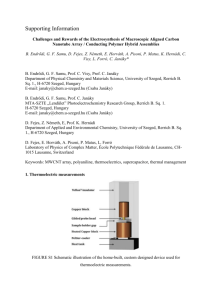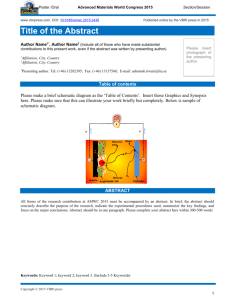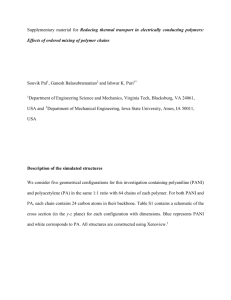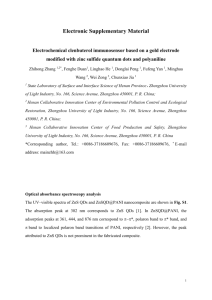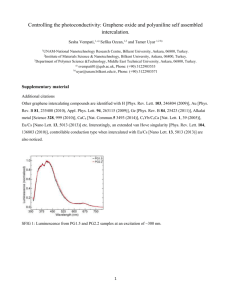Infrared optics applications of the thin polyaniline emeraldine base
advertisement
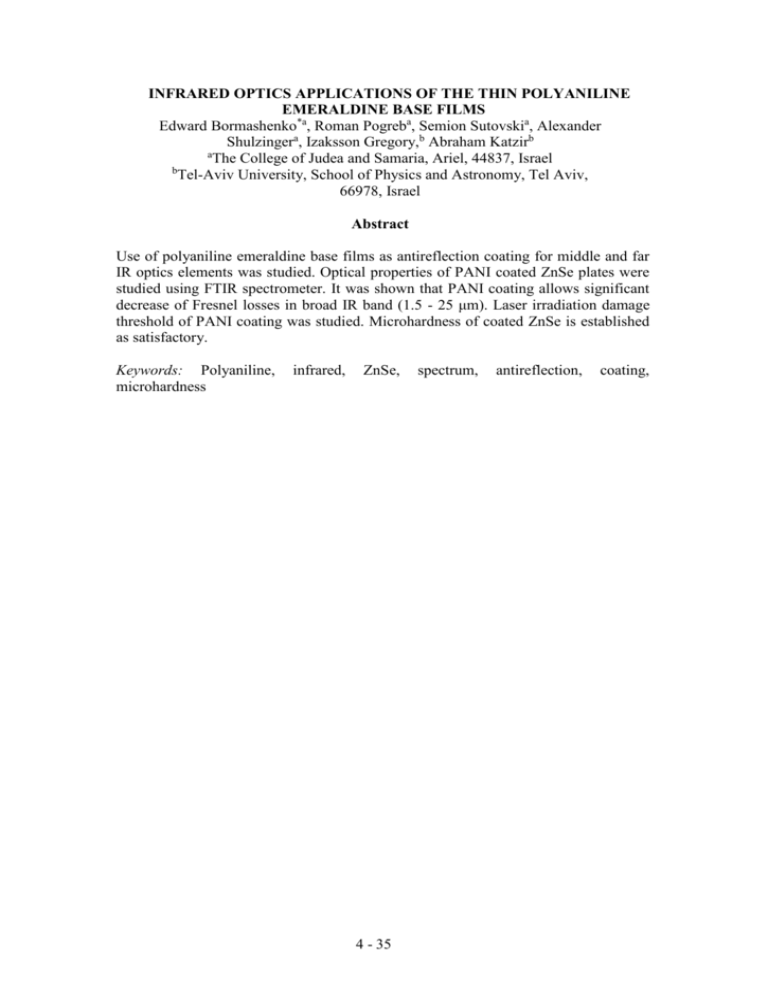
INFRARED OPTICS APPLICATIONS OF THE THIN POLYANILINE EMERALDINE BASE FILMS Edward Bormashenko*a, Roman Pogreba, Semion Sutovskia, Alexander Shulzingera, Izaksson Gregory,b Abraham Katzirb a The College of Judea and Samaria, Ariel, 44837, Israel b Tel-Aviv University, School of Physics and Astronomy, Tel Aviv, 66978, Israel Abstract Use of polyaniline emeraldine base films as antireflection coating for middle and far IR optics elements was studied. Optical properties of PANI coated ZnSe plates were studied using FTIR spectrometer. It was shown that PANI coating allows significant decrease of Fresnel losses in broad IR band (1.5 - 25 μm). Laser irradiation damage threshold of PANI coating was studied. Microhardness of coated ZnSe is established as satisfactory. Keywords: Polyaniline, microhardness infrared, ZnSe, 4 - 35 spectrum, antireflection, coating, 1. Introduction The optical properties (including the precise measurement of refractive index) of polyaniline and its derivatives have been the subject of much investigation recently [1-3]. IR spectra of polyaniline its solutions and related compounds were studied thoroughly [4-8]. It could be recognized from the analysis of the spectral data that PANI demonstrates high transparency in broad middle and far infrared bands, this fact makes it suitable for coating of IR optics elements. In addition to that PANI solutions allow production of thin films with thickness, which could be controlled with high accuracy necessary for optical coating. All materials used in the field of IR optics (ZnSe, ZnS, Ge, AgCl, AgBr) suffer from the same disadvantage: high Fresnel losses, dictated by a high refraction index [9-10]. Usually this problem is surmounted by applying of antireflection coating to the surface of IR optics element [9-10]. Such coating in addition to antireflection effect and high transparency in broad IR band has to demonstrate good adhesion to the material to be coated, satisfactory surface hardness, high laser radiation damage threshold and thermal stability of optical constants. The best possible coating in use today is diamond coating, which raises prices of IR windows and lenses significantly. We supposed that PANI coating could supply all above-listed properties. Very few reports were devoted to the study of the interaction of PANI derivatives with strong IR laser radiation [11-13], at the same time extremely high optical damage threshold measured at wavelength 1064 nm, established as 10GW/cm2 for polyethoxyaniline is signed in [11]. The most abundant material used for IR optical purposes is ZnSe, so we concentrated our efforts in the development of PANI coating of ZnSe IR windows at this stage of our investigation. PANI is only partially dissolved in dymethylsulfoxide (DMSO) [14], but we chose (DMSO) as a solvent for PANI emeraldine base, because Se demonstrates weak solubility in DMSO [15], so some etching effect is possible at the interface ZnSe/PANI DMSO solution, which could provide good adhesion of PANI film to the surface of the ZnSe window to be coated. 2. Experimental Polyaniline emeraldine base and dimethylsulfoxide were supplied by SigmaAldrich Israel Ltd. ZnSe plates were supplied by Eksma Ltd, parameters of the plates: transmission band: 0.6-22 μm, refractive index in the band 8- 13 μm: n = 2.417-2.385, flatness λ/60, parallelism 3 arcmin. Saturated PANI solutions in DMSO were prepared .PANI EB films with a thickness 100-2000 nm were applied to ZnSe substrates by spin-casting process. Films were exposed to vacuum evaporation. Then part of PANI coated ZnSe surface was polished, in order to compare optical parameters of coated and uncoated ZnSe substrates. Optical quality of obtained EB PANI coating was controlled using Linnik interferometer combined with optical microscope. Absorbance spectrum of coated and uncoated ZnSe substrates in the middle and far IR bands was established using Bruker Vector 22 FTIR spectrometer, and the same in the near IR band with Varian Cary 500 spectrophotometer. Then films were exposed to strong IR radiation produced by Apollo Inc. CO2 laser. Comparative surface hardness of coated and original ZnSe surfaces was measured with Buehler 2100 microhardness tester. 4 - 36 3. Results and discussion Presence of solvent traces in obtained PANI EB films applied to ZnSe substrates is crucial for the optical quality of coating (solvent traces produce additional “dips” in absorption spectrum). We developed optical bench, which allowed “real time” control of the process of vacuum evaporation of coated ZnSe substrates described in Fig.1. Absorption spectra of PANI EB coating were taken when vacuumed using FTIR spectrometer Bruker Vector 22. Evaporation of the solvent has been accompanied with the changes in the absorption spectra (see Fig.2). Very strong line of water (0.2% of water is present in DMSO) located between 3400 and 3700 cm-1, “dips” at 3000 and 2910 cm-1 inherent for the vibrations of CH3 group, very strong “dip” at 1033 cm-1 inherent for S=O group of DMSO disappear under vacuum evaporation. The termination of such changing is indicative of the net removal of the solvent from the PANI EB film. It could be recognized from the final spectrum of the evaporated film (Fig. 2) that PANI EB coating is highly transparent in the broad middle and far IR bands 2.0-6 μm Absorption spectrum of evaporated ZnSe substrate coated with PANI EB film measured with near IR spectrophotometer leads to the conclusion that the window of high transparency extends to 1.0 μm (the same results concerning near IR spectrum of PANI were reported by F.Fitrilawati, M.O. Tija [11]), so the results of the spectral measurements when combined suggest that thin PANI EB layers produce highly transparent coating in the range 1.0-6.0 μm. This fact makes them suitable for various IR optics applications. It has to be signed that thin PANI EB layers (up to 200 nm) provided good optical qualities of the coated ZnSe subtrates. Images obtained using Linnik interferometer-microscope revealed the high homogeneity of the optical constants of the coating (see Fig. 3). On the other hand coatings with comparatively high thickness (more than 1000 nm) didn’t provide satisfactory optical quality. Resistance of the coating layer to the powerful IR radiation is crucial for its IR optics applications. In order to test the optical quality of PANI EB coating under strong IR radiation we used optical bench presented at Fig.4 Radiation produced by CO2 laser was directed on the PAN EB coated ZnSe plate at small incident angle. IR radiation detector A measured the power transmitted trough the sample It, and detector B indicated power of the reflected beam Ir. The total incident power Ii = It +Ir (when absorption in the sample is neglected), and transmission coefficient R is given as R = It/Ii. Fig. 5 presents dependence R(Ii*), where Ii* - power density of the incident beam. It can be recognized that PANI EB coated ZnSe plates demonstrate stable transmission coefficient (R = 0,75-0.76) up to very high power densities as high as 3 W/mm2. It could be recognized from the absorbance spectrum, presented at Fig.2, that 10.6 μm – wavelength of CO2 laser – located in the “problematic” part of PANI EB spectrum, absorption at this wavelength is not minimal, this makes the results of the test all the more important for further IR optics applications of PANI EB coating layers. Another parameter important for IR optics applications is hardness of the coating layer. Microhardness of PANI EB layer (150 nm thickness) applied to ZnSe substrate was established as 90 HV (load 10g), comparatively to 120 HV measured for uncoated ZnSe substrate. Despite some decrease of the microhardness of the substrate when coated it could be concluded that PANI EB layers form surface layers with satisfactory mechanical properties. 4 - 37 4. Conclusions Thin PANI EB demonstrated layers demonstrated their suitability as a coating of IR optics elements. The broad window of transparency in the IR band, high stability under strong IR radiation, good surface hardness make them attractive for different IR optics applications, such as anti-reflecting coating of IR windows, lenses, etc. Acknowledgements This work was supported by the Israel Ministry of Science, Culture and Sport (Project No. 1461-2-00) and Israel Ministry of Absorption The authors are thankful to Mr. Avigdor Sheshnev for his assistance in the analysis of the spectral data. References [1] R.P.Sharma, M.S. Raghuvanshi, S.V. Bhasvar, A.R. Patil, S.C.K. Misra, Polymers for Advanced Technologies 13 (2002) 475. [2] G.S. Maciel, A.G.Jr., Bezerra, N. Rakov, Journal of the Optical Society of America B, Optical Physics 18 (8) (2001) 1099. [3] M. Dang, L. Yongyao, W. Hui, Y. Zhaoxian, in SPIE Proceedings, 2397 (1995) 117. [4] S. Quillard, G. Louarn, S. Lefrant, A.G. Macdiarmid, Physical Review B, 50 (17), (1994) 12 496. [5] I. Harada, Y. Furukawa, F. Ueda, Synthetic Metals, 29 (1989), E303. [6] O.P.Dimitriev, Synthetic Metals, 125 (2002), 359. [7] S. Mu, J. Kan, Synthetic Metals, 98 (1998), 51. [8] S. Folch, A. Gruger, A.Regus, Ph. Colomban, Synthetic metals 81, (1996), 221. [9] D.C.Harris, Materials for Infrared Windows and Domes: Properties and Performance, SPIE Press, Bellingham, 1999. [10] P.Klocek, Handbook of Infrared Optical Materials, Marcel Dekker, New York, 1991. [11] F.Fitrilawati, M.O. Tija, Optical Materials,16, (2001), 367. [12] T.S.Zhuravleva, A.V.Gladkevitch, P.I.Misurkin, Synthetic Metals, 69, (1995), 269. [13] V.E.Bondarenko, T.S.Zhuravleva, O.N.Efimov, G.V.Nikolaeva, Synthetic Metals, 102 (1999), 1228. [14] P.Ghosh, S.K.Siddhanta, S. Rejaul Haque, A.Chakrabatri, Synthetic Metals, 123, (2001), 83. [15] D. Gal, G. Hodes, Journal of the Electrochemical Society, 147 (5), (2000), 1825. 4 - 38 IR detector ZnSe windows w hermetic cell vacuum pump PANI layer under vacuum evaporation FTIR PANI coated ZnSe plate Fig.1. Optical bench, intended for controlling of the vacuum evaporation of PANI films 4 - 39 Fig.2. Changes in the PANI EB solution spectrum under vacuum evaporation 4 - 40 Fig. 3. Image of the surface of EB PANI coated (dark field) and uncoated (light field) ZnSe substrate obtained with Linnik interferometer-microscope (magnification 500, wavelength – λ = 526 nm). The thickness of the film is established as λ/4 ~ 130 nm) 4 - 41 IR powermeter B mirror CO2 laser PANI coated ZnSe plate IR powermeter A Fig. 4. Optical bench used for the exposure of PANI EB coated substrates to the strong continuous IR radiation 4 - 42 Fig. 5. Transmission coefficient measured at different power densities 4 - 43

